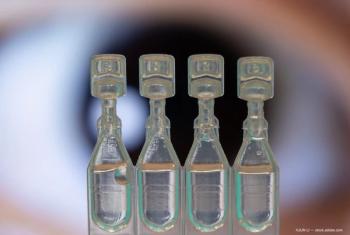
Retinal cells may have potential to protect themselves from diabetic retinopathy
According to researchers, cells within retinal blood vessels are endowed with a previously unappreciated ability to acquire resistance against the damaging effects of hyperglycemia in patients with diabetes mellitus.
About one third of patients with diabetes mellitus (DM) develop diabetic retinopathy (DR), a leading cause of blindness in working-age individuals. DR typically develops after many years of DM, and some patients do not develop DR for more than 50 years. New research suggests that an endogenous system that protects human retinal endothelial cells from harmful effects of the hyperglycemia (an excess of blood sugar) may be responsible for the delayed onset of DR. Furthermore, degradation of this protective system over time may set the stage for development of DR.
The new study1 appears in the American Journal of Pathology.
According to Andrius Kazlauskas, PhD, Departments of Ophthalmology and Visual Sciences and Physiology and Biophysics, University of Illinois at Chicago, the general understanding of what causes DR predicts that it will develop soon after the onset of DM.
“Yet this is not the case,” Kazlauskas explained. “Although the long delay from the onset of DM to the development of DR is a well-known clinical phenomenon, there is relatively little effort to investigate the underlying reason for this delay. Uncovering this information constitutes an exciting opportunity to improve current approaches to prevent DM from progressing to DR.”
Exposing cultured cells, such as vascular endothelial cells, to high glucose is a common in vitromodel of DR. The investigators cultured human retinal endothelial cells in either normal glucose or high glucose–containing media. Unexpectedly, they found that prolonged exposure to high glucose was beneficial, not detrimental. After one day, the health of the cells declined, but as the duration of exposure was prolonged, the cells recovered and acquired resistance to DM-related damage such as inflammation and death.
According to the news release, the investigators found that the adaptation was associated with improved mitochondria functionality. Mitophagy is the process in which cells remove damaged mitochondria, and disruption of this intrinsic quality control system is associated with many diseases. Though initially compromised, mitochondrial functionality was improved after 10 days of exposure to high glucose, with increased clearance of damaged mitochondria. Interfering with the mitochondrial dynamics compromised the cells’ ability to endure high glucose. Susceptibility to cell death increased, and responsiveness of vascular endothelial growth factor deteriorated.
Kazlauskas said these observations indicate the existence of an endogenous system that protects human retinal endothelial cells from the deleterious effects of hyperglycemia. “The compelling role of mitochondrial dysfunction in the development of DR supports our central concept of a hyperglycemia-induced mitochondrial adaptation (HIMA) system, the purpose of which is to preserve the functionality of mitochondria. We posit that the loss of HIMA sets the stage for advancing to DR.”
An important component of the HIMA concept is that improving the functionality of a subset of retinal cells will be beneficial for the whole retina. Previous research has found even a small reduction in degree or type of insult to the retina can protect animals that have DM from developing DR. Together these discoveries suggest that the development of DR involves a relatively small shift in the balance between exogenous insults and the endogenous systems that prevent DM-driven damage and drivers of pathogenesis.
Kazlauskas observed that the increasing incidence of DM, and consequently of DR, around the world exacerbates the need for effective approaches to protect patients from this serious complication.
“Does HIMA exist in vivo, does it protect patients from DR, and is its demise a prerequisite for progression to DR? Our ongoing research is focused on answering these open questions,” he concluded.
Newsletter
Don’t miss out—get Ophthalmology Times updates on the latest clinical advancements and expert interviews, straight to your inbox.














































.png)


